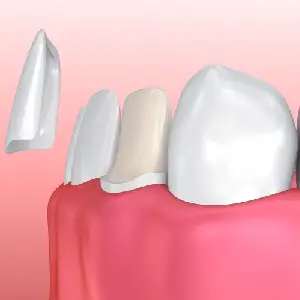Dental veneers have become a popular solution for improving smiles, addressing issues like stains, chips, and alignment problems. However, a common question when considering veneers is, “Can you go back to normal teeth after veneers?”
Keep reading to find an answer to that very question, explaining whether it’s possible to return to your natural teeth after veneers, what alternatives exist if you decide against them, and how the veneer process works.

What Are Dental Veneers?
Dental veneers are thin, custom-made shells that cover the front surface of your teeth, improving their appearance. They are made of porcelain or composite resin and are bonded to your teeth to fix cosmetic issues such as:
- Stains or discoloration
- Chips or cracks
- Gaps between teeth
- Minor misalignment
Veneers are a great option for those seeking a more uniform smile without requiring extensive dental procedures like braces. However, one important thing to consider before getting veneers is that they are irreversible due to the need for enamel removal.
Can You Go Back to Normal Teeth After Veneers?
Once you get traditional porcelain veneers, you cannot completely return to your natural teeth. Here’s why:
- Enamel Removal: A small amount of natural tooth enamel is removed to ensure the veneer fits properly. This process is permanent, as enamel cannot regenerate.
- Long-Term Changes: The tooth structure is altered, and after veneers are placed, the tooth becomes more susceptible to sensitivity and decay if the veneers are removed.
If you remove your veneers after they have been placed, your natural tooth will be exposed, and it will have a slightly different structure than before. This means that you cannot go back to your original teeth after veneers.
What to Expect During the Veneer Process: A Step-by-Step Procedure
If you decide to move forward with traditional veneers, here’s a breakdown of what you can expect during the treatment process:
1. Consultation and Assessment
Your dentist will evaluate your oral health and discuss your goals. During this phase, they may take X-rays to ensure your teeth are healthy and suitable for veneers.
2. Tooth Preparation
A small amount of enamel is removed from the surface of your teeth to allow space for the veneers to fit snugly. The dentist will then take impressions of your teeth to create custom veneers.
3. Bonding the Veneers
Once your veneers are ready, your dentist will check the fit and color to ensure they look natural. The veneers are then permanently bonded to your teeth using a special dental adhesive.
Can You Get Another Set of Veneers?
Yes, you can get another set of veneers if you decide to replace the ones you have. However, there are a few important considerations to keep in mind:
- Altered Tooth Structure: Traditional veneers require removing a small amount of enamel, so your teeth will have changed structurally. This means that a new set of veneers may not fit as perfectly or last as long as the original ones. The altered tooth surface could also affect the overall aesthetic outcome.
- Alternative Options: If you’re not satisfied with the results of your current veneers, it’s worth exploring alternatives like dental crowns or bonding. Depending on the condition of your teeth and your goals, these options may be more suitable for achieving the desired outcome without the need for additional veneer placements.
It’s essential to discuss your concerns with your dentist to determine whether replacing your veneers or exploring other solutions is the best option for you.
Are There Reversible Alternatives to Veneers?
If you’re looking for a more reversible cosmetic dental option or simply want the flexibility to return to your natural teeth in the future, there are a few great alternatives to traditional veneers. These options allow you to enhance your smile without committing to irreversible changes.
1. No-Prep Veneers
No-prep veneers are a thinner alternative to traditional porcelain veneers and don’t require the removal of enamel. They can be placed directly over your natural teeth, making them a more reversible option. If you ever decide to remove them, your natural teeth remain intact, and no permanent alterations have been made. No-prep veneers are ideal for those who want a less invasive procedure but still desire the aesthetic benefits of veneers.
2. Dental Bonding
Dental bonding involves the application of a tooth-colored resin to the surface of your teeth, reshaping and covering imperfections. This technique is less invasive and fully reversible, as it doesn’t require enamel removal. However, bonding may not last as long as veneers and may require occasional touch-ups, especially if you have habits like teeth grinding.
3. Other Alternatives to Veneers
While veneers are a great solution for many, they are not the only option for improving the appearance of your teeth. If you’re unsure about the permanence of veneers or want to explore other choices, here are some alternatives:
- Teeth Whitening: If your primary concern is discoloration, professional teeth whitening treatments can significantly improve the brightness of your smile. Whitening doesn’t alter the tooth structure, making it a noninvasive option for those seeking a brighter smile without permanent changes.
- Dental Crowns: Dental crowns may be a better option for teeth that are severely damaged, worn, or have large cavities. They provide full coverage, restoring the tooth’s shape, size, and functionality while offering a natural appearance. Crowns are typically more suitable for damaged teeth than veneers.
- Orthodontics: If alignment issues are the primary concern, braces or clear aligners like Invisalign could be a better long-term solution. Orthodontics focuses on adjusting the position of your teeth without altering the natural structure, making them an effective alternative to veneers for people with misaligned teeth.
Takeaway
Can you go back to normal teeth after veneers?” The answer depends on the type of veneer used. Traditional porcelain veneers are irreversible, as they require the removal of tooth enamel, making it impossible to return to your original, untreated teeth. However, no-prep veneers and dental bonding provide more reversible options if you want flexibility in the future.
If you’re uncertain about veneers, consult your dentist to explore alternatives and choose the best treatment.
Book a Consultation with Centers for Dental Implants
If you’re considering veneers or exploring other cosmetic dental options, book a consultation with our expert team at Centers for Dental Implants today. We’ll guide you through your options and help you achieve the smile you’ve always dreamed of!
FAQs
Can I change my veneers if I don’t like them?
If you’re unsatisfied with your veneers, you can discuss adjustments or replacements with your dentist. However, replacing veneers involves another procedure, and the tooth structure may have already changed due to the initial enamel removal.
Are veneers worth it?
Veneers are an excellent solution for improving the appearance of your teeth, especially if you have issues like discoloration, chips, or gaps. They provide a long-lasting and natural-looking result, but it’s essential to understand that the process is irreversible.
Can you remove veneers at any time?
While it’s possible to remove veneers, it’s not recommended because doing so exposes your natural teeth, which may be altered from their original condition. Removal can also lead to increased sensitivity and potential complications.
How long do veneers last?
With proper care, veneers can last anywhere from 10 to 15 years, depending on the material used and your oral hygiene habits.
What happens if I remove my veneers?
If you remove traditional veneers, your natural teeth will be exposed, and you may experience increased sensitivity and discomfort. If you’ve had significant enamel removed, the underlying tooth structure may be vulnerable to decay or damage.

